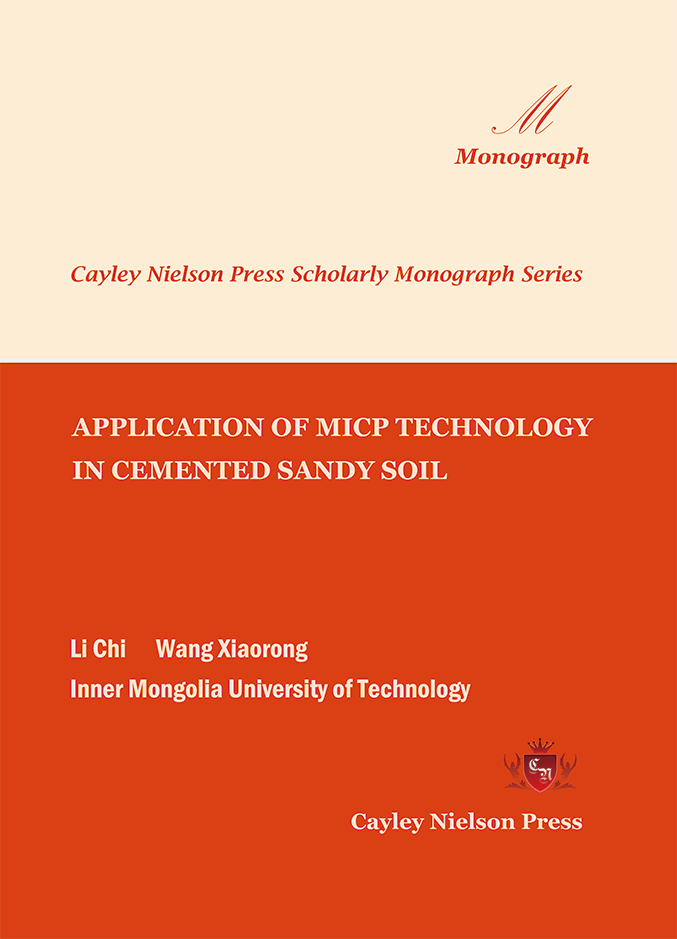
APPLICATION OF MICP TECHNOLOGY IN CEMENTED SANDY SOIL

APPLICATION OF MICP TECHNOLOGY IN CEMENTED SANDY SOIL
Li Chi, Wang Xiaorong
Inner Mongolia University of Technology
Copyright © 2021 by Cayley Nielson Press, Inc.
ISBN: 978-1-957274-01-0
Cayley Nielson Press Scholarly Monograph Series Book Code No.: 211-12-7
US$150.00
Preface
Microbial-induced carbonate deposition (MICP) technology based on biomineralization has been highly valued by the researchers in geotechnical and civil engineering materials, in which urease-producing microorganisms are used to rapidly induce a large number of carbonate crystals to fill and reinforce sandy soil, and thus it is becoming a hot research topic in biological geotechnical engineering in recent years. However, at present, this technology has many limitations and lacks in-depth work on the principle of microbial mineralization and its durability mechanism in harsh environments.
This book is committed to detailed research work on the application of Microbial Induced Calcite Precipitation (MICP) technology cemented sandy soil from the following aspects: principles of reinforced, laboratory preparation methods and influence factors, brittleness and erosion resistance improved after mineralization, and application of the in-site on Aeolian sand in desert. The purpose of this book is to reveal the differences of formation, structure and performance of carbonate crystals between induced from microorganism and produced from chemistry, and also to reveal the ingenious assembly process between carbonate crystals and sand particles and its fine microstructure under specific biological conditions. It can provide structural support for loose sand particles, and at the same time it also has a kind of structures with a certain mechanical strength, controllable generation speed and material strength produced through filling, cementation, and friction between carbonate crystals and sand particles under strict biological control. It can well meet specific environmental durability requirements, showing the advantage of biomineralization, especially in the context of green and low carbon transformation of energy and realize the goal of “dual carbon reduction”. It has wide application in geotechnical engineering and civil materials for Microbial Induced Carbonate Precipitation (MICP) technology on the basis of biomineralization.
This research project was funded by the National Natural Science Foundation of China (51668050, 51968057) and the key technology research project of Inner Mongolia science and technology plan (2021GG0344). The recent research achievements from Zhao Qian, Li Mingdong, Liu Shihui, Zhou Tuanjie, Li Hongyan, Fan Wenhan, Wang Xiaorong, Gao Yu, Siriguleng are cited in the book. We would like to thank you for your innovative achievements and pioneering spirit of scientific research. It is believed that the publication of this new book will play a positive role in expanding the engineering application of microbial induced carbonate deposition (MICP) technology. It is hoped that through publishing this new book, it will be able to inspire others and scholars who are interested in the field of biogeotechnical engineering to discuss together and enlighten each other. There may be some inadequacies and deficiencies in this book, I sincerely hope all experts, scholars and peers can provide comments and correct them. Thanks.
Li Chi
Hohhot, Inner Mongolia, China
Xinchou year-end,2021
Contents
Preface 1
Chapter 1 Introduction of MICP Technology 5
1.1 MICP Technology 5
1.2 Mineralization mechanism 7
1.3 Application 11
1.4 Influencing factors 18
Chapter 2 MICP Specimen Preparation 25
2.1 Introduction 25
2.2 Full contact flexible mold(FCFM) 27
2.2.1 Experimental Methods and Materials 27
2.2.2 Results 29
2.3 Effect of different geotextile FCFMs on MICP treated samples 32
2.3.1 Materials and Methods 32
2.3.2 Results and Discussion 40
2.4 Conclusions 51
Chapter 3 Experimental study on influencing factors of MICP 54
3.1 Introduction 54
3.2 Effects of bacteria and urease catalysis 57
3.2.1 Materials and Methods 57
3.2.2 Results and Discussion 63
3.3 Impact of Oxygen Availability 78
3.3.1 Materials and preparation of specimens 78
3.3.2 Test method 79
3.3.3 Results and discussion 81
3.4 Conclusions 88
Chapter 4 Brittleness improvement 92
4.1 Introduction 92
4.2 Influence of Fiber Addition 97
4.2.1 Materials and Testing Methods 97
4.2.2 Results and Discussion 102
4.2.3 Conclusions 113
4.3 Microbial treatment 115
4.3.1 Materials and Methods 115
4.3.2 Results 121
4.3.3 Discussion and Conclusion 130
Chapter 5 Anti-erosion characteristics 137
5.1 Anti-erosion enhancement 137
5.1.1 Introduction 137
5.1.2 Laboratory test 138
5.2 Fiber reinforcement bio-bricks 162
5.2.1 Introduction 162
5.2.2 Preparation of bio-bricks 165
5.2.3 Mechanical test of bio-bricks 170
5.2.4 Results and discussions 173
5.2.5 Conclusion 186
Chapter 6 Application of Wind erosion Prevention in Desert 188
6.1 Staphylococcus isolated from desert 188
6.1.1 Introduction 188
6.1.2 Isolation and optimization of microorganisms 189
6.1.3 Mineralized Aeolian sandy soil 201
6.1.4 Conclusion 211
6.2 Improvement of Geomechanical Properties 212
6.2.1 Introduction 212
6.2.2 Experimental materials 215
6.2.3 Experimental methods 218
6.2.4 Results and discussion 222
6.2.5 Conclusions 230
References 232
Readership
This book should be useful for students, scientists, engineers and professionals working in the areas of optoelectronic packaging, photonic devices, semiconductor technology, materials science, polymer science, electrical and electronics engineering. This book could be used for one semester course on adhesives for photonics packaging designed for both undergraduate and graduate engineering students.
